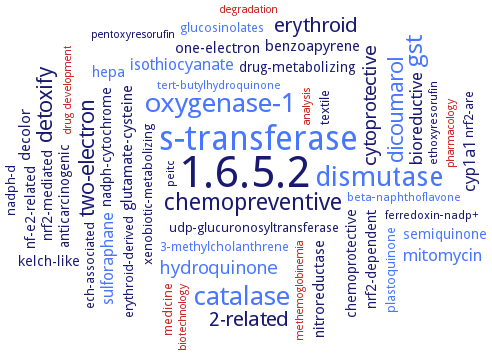1.6.5.2: NAD(P)H dehydrogenase (quinone)
This is an abbreviated version!
For detailed information about NAD(P)H dehydrogenase (quinone), go to the full flat file.

Word Map on EC 1.6.5.2 
-
1.6.5.2
-
s-transferase
-
dismutase
-
oxygenase-1
-
catalase
-
gst
-
chemopreventive
-
detoxify
-
two-electron
-
dicoumarol
-
2-related
-
erythroid
-
cytoprotective
-
hydroquinone
-
bioreductive
-
mitomycin
-
sulforaphane
-
isothiocyanate
-
cyp1a1
-
nitroreductase
-
decolor
-
hepa
-
one-electron
-
glutamate-cysteine
-
benzoapyrene
-
nrf2-mediated
-
semiquinone
-
chemoprotective
-
nadph-cytochrome
-
nrf2-dependent
-
kelch-like
-
drug-metabolizing
-
nf-e2-related
-
anticarcinogenic
-
medicine
-
glucosinolates
-
plastoquinone
-
nadph-d
-
textile
-
ech-associated
-
3-methylcholanthrene
-
xenobiotic-metabolizing
-
nrf2-are
-
udp-glucuronosyltransferase
-
erythroid-derived
-
ethoxyresorufin
-
beta-naphthoflavone
-
tert-butylhydroquinone
-
ferredoxin-nadp+
-
peitc
-
pharmacology
-
drug development
-
analysis
-
degradation
-
methemoglobinemia
-
pentoxyresorufin
-
biotechnology
- 1.6.5.2
- s-transferase
- dismutase
- oxygenase-1
- catalase
- gst
-
chemopreventive
-
detoxify
-
two-electron
- dicoumarol
-
2-related
-
erythroid
-
cytoprotective
- hydroquinone
-
bioreductive
- mitomycin
- sulforaphane
- isothiocyanate
- cyp1a1
- nitroreductase
-
decolor
- hepa
-
one-electron
-
glutamate-cysteine
-
benzoapyrene
-
nrf2-mediated
- semiquinone
-
chemoprotective
-
nadph-cytochrome
-
nrf2-dependent
-
kelch-like
-
drug-metabolizing
-
nf-e2-related
-
anticarcinogenic
- medicine
- glucosinolates
- plastoquinone
- nadph-d
-
textile
-
ech-associated
- 3-methylcholanthrene
-
xenobiotic-metabolizing
-
nrf2-are
-
udp-glucuronosyltransferase
-
erythroid-derived
-
ethoxyresorufin
- beta-naphthoflavone
- tert-butylhydroquinone
-
ferredoxin-nadp+
-
peitc
- pharmacology
- drug development
- analysis
- degradation
- methemoglobinemia
-
pentoxyresorufin
- biotechnology
Reaction
Synonyms
1,4-benzoquinone reductase, azoreductase, chromate reductase, ChrR, dehydrogenase, reduced nicotinamide adenine dinucleotide (phosphate, quinone), diaphorase, DPND, DPNH-diaphorase, DT-diaphorase, DTD, DVU_2399, DVU_2400, DVU_2401, EC 1.6.99.2, FerB, ferric reductase B, flavoprotein NAD(P)H-quinone reductase, FlxABCD, FMN-dependent NAD(P)H:quinone oxidoreductase, Internal NADH dehydrogenase, MdaB, Menadione oxidoreductase, Menadione reductase, NAD(P)H dehydrogenase, NAD(P)H dehydrogenase complex, NAD(P)H menadione reductase, NAD(P)H quinone oxidoreductase, NAD(P)H quinone oxidoreductase-1, NAD(P)H quinone oxidoreductase1, NAD(P)H quinone reductase, NAD(P)H quinone-oxidoreductase 1, NAD(P)H-QR, NAD(P)H-quinone dehydrogenase, NAD(P)H-quinone oxidoreductase, NAD(P)H: (quinone acceptor) oxidoreductase, NAD(P)H: (quinone-acceptor)oxidoreductase, NAD(P)H: menadione oxidoreductase, NAD(P)H: Quinone oxidoreductase, NAD(P)H: quinone oxidoreductase 1, NAD(P)H: quinone oxidoreductase-1, NAD(P)H: quinone reductase, NAD(P)H:acceptor oxidoreductase, NAD(P)H:quinone acceptor oxidoreductase, NAD(P)H:quinone oxidoreducatase 1, NAD(P)H:quinone oxidoreductase, NAD(P)H:quinone oxidoreductase 1, NAD(P)H:quinone oxidoreductase I, NAD(P)H:quinone oxidoreductase-1, NAD(P)H:quinone reductase, NAD(P)H:quinoneoxidoreductase 1, NADH-menadione reductase, NADH:quinone oxidoreductase 1, NADPH quinone reductase, NADPH: quinone oxidoreductase-1, NADPH:quinone oxidoreductase, NADPH:quinone oxidoreductase 1, NAD[P]H:quinone acceptor oxidoreductase 1, Naphthoquinone reductase, Ndh complex, NDH2, nicotinamide adenine dinucleotide phosphate:quinone oxidoreductase 1, NQO1, NQR, NRH:quinone reductase 1, p-Benzoquinone reductase, Pden_4071, PfNdh2, Phylloquinone reductase, QOR2, QR1, QR2, Quinone reductase, quinone reductase 1, quinone reductase type 1, Reduced NAD(P)H dehydrogenase, reduced nicotinamide-adenine dinucleotide (phosphate) dehydrogenase, TcpB, TmQR2, type II NADH: quinone oxidoreductase, Viologen accepting pyridine nucleotide oxidoreductase, Vitamin K reductase, vitamin-K reductase, WrbA


 results (
results ( results (
results ( top
top






